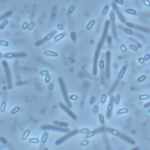Link to Pubmed [PMID] – 12637536
J. Biol. Chem. 2003 May;278(21):18754-60
We describe here new members of the H-NS protein family identified in a psychrotrophic Acinetobacter spp. bacterium collected in Siberia and in a psychrophilic Psychrobacter spp. bacterium collected in Antarctica. Both are phylogenetically closely related to the HvrA and SPB Rhodobacter transcriptional regulators. Their amino acid sequence shares 40% identity, and their predicted secondary structure displays a structural and functional organization in two modules similar to that of H-NS in Escherichia coli. Remarkably, the Acinetobacter protein fully restores to the wild-type H-NS-dependent phenotypes, whereas the Psychrobacter protein is no longer able to reverse the effects of H-NS deficiency in an E. coli mutant strain above 30 degrees C. Moreover, in vitro experiments demonstrate that the ability of the Psychrobacter H-NS protein to bind curved DNA and to form dimers is altered at 37 degrees C. The construction of hybrid proteins containing the N- or the C-terminal part of E. coli H-NS fused to the C- or N-terminal part of the Psychrobacter protein demonstrates the role of the N-terminal domain in this process. Finally, circular dichroism analysis of purified H-NS proteins suggests that, as compared with the E. coli and Acinetobacter proteins, the alpha-helical domain displays weaker intermolecular interactions in the Psychrobacter protein, which may account for the low thermal stability observed at 37 degrees C.


